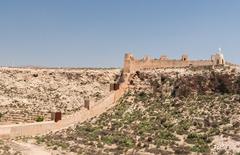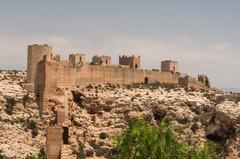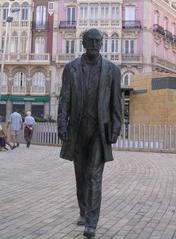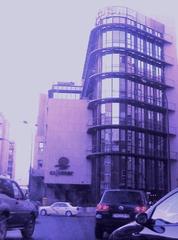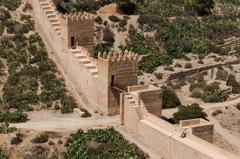
Muralla Urbana & Muralla de Jayrán, Almería: Complete Visiting Guide (2025)
Date: 14/06/2025
Introduction: Unveiling the Muralla Urbana & Muralla de Jayrán
The Muralla Urbana, highlighted by the notable Muralla de Jayrán, is a defining monument in the city of Almería, southern Spain. Built in the 11th century during the Islamic period, these city walls once protected a thriving port city established in 955 CE by Caliph Abd-ar-Rahman III. The Muralla Urbana, with its strategic location and robust design, not only safeguarded Almería from both land and sea threats but also signified the city’s stature as a cultural and commercial Mediterranean hub (Turismo de Almería; Lonely Planet).
This guide provides a detailed exploration of the Muralla de Jayrán’s history, architectural features, and its lasting influence on the cityscape. You’ll also find up-to-date visiting hours, ticket information, accessibility details, tips for guided tours, and recommendations for nearby attractions. Whether you are a history buff or a casual traveler, understanding the walls’ historical and cultural significance will greatly enhance your visit (The Crazy Tourist; Odyssey Magazine).
Table of Contents
- Introduction
- Historical Origins & Development
- Architectural Features & Defensive Role
- Islamic & Christian Eras: Shifting Powers
- Decline, Rediscovery & Preservation
- Archaeological & Cultural Significance
- Practical Visitor Information
- Muralla Urbana in Modern Almería
- Key Facts & Dates
- Frequently Asked Questions
- Conclusion & Call to Action
- References
Historical Origins & Development
Founded in 955 CE by Abd-ar-Rahman III, Almería quickly rose to prominence as a fortified port city. The Muralla de Jayrán, constructed under the 11th-century Taifa king Jayrán, expanded the city’s defenses, especially on its northern and eastern sides. These walls linked directly with the Alcazaba — then the largest Muslim fortress in Europe — forming an integrated defensive network (Turismo de Almería). The city walls facilitated Almería’s growth as a commercial center, attracting traders from across the Mediterranean (The Crazy Tourist).
Architectural Features & Defensive Role
Built with local stone and brick, the Muralla Urbana showcased advanced Islamic military engineering. Key elements included:
- Battlements & Towers: Strategically placed for visibility and defense, including signaling towers on Cerro de San Cristóbal.
- Fortified Gates: Controlled entry points such as the Puerta de la Justicia, which led into the Alcazaba (Lonely Planet).
- Cisterns & Storage: Integrated to ensure water supply during sieges.
The defensive role of the walls extended beyond mere military function, serving as a deterrent and symbol of the city’s autonomy and resilience (Odyssey Magazine).
Islamic & Christian Eras: Shifting Powers
During the 11th and 12th centuries, Almería thrived as a center of commerce and culture under Islamic rule (Turismo de Almería). The Muralla Urbana was vital in defending against both internal and external threats. After the Christian conquest in 1489, the walls were adapted for new defensive needs, including protection from pirate attacks. The construction of fortress-like structures, such as the Cathedral of Almería, reflected ongoing security concerns (The Crazy Tourist).
Decline, Rediscovery & Preservation
Through the modern era, urban expansion and changing military needs led to the partial demolition of the walls. However, significant sections — particularly the Muralla de Jayrán — remain, thanks to preservation and restoration initiatives (Nomads Travel Guide). Civic activism in the late 20th century accelerated rediscovery and protection efforts, ensuring that these medieval fortifications are now recognized as key cultural assets.
Archaeological & Cultural Significance
Archaeological excavations have uncovered ceramics, inscriptions, and everyday objects, many of which are displayed at the Museum of Almería (Museum of Almería). The walls reflect Almería’s multicultural history, blending Islamic, Christian, Roman, and Phoenician influences. Their preservation supports educational programs, guided tours, and community events (Odyssey Magazine).
Practical Visitor Information
Visiting Hours & Tickets
- Muralla de Jayrán: Generally open daily, 10:00 AM–6:00 PM, with extended summer hours. The site is often free to explore, though some special exhibitions or guided tours may require tickets.
- Alcazaba Fortress: Tickets required; typical hours are 9:00 AM–6:00 PM (winter) and 9:00 AM–9:00 PM (summer). Free for EU citizens; €1.50 for non-EU visitors (andalucia.com).
- Check for updates on official tourism portals.
Accessibility
- The main sections near the city center are accessible, but upper areas and Cerro de San Cristóbal involve stairs and uneven ground. Wheelchair users may require assistance.
Guided Tours & Events
- Guided tours are available via the municipal tourist office at Calle Juez 6 and online. Special events, such as historical reenactments and night tours, are held throughout the year.
Photography & Scenic Spots
- The walls and Cerro de San Cristóbal provide panoramic city and sea views, especially at sunrise and sunset. Use keywords like “Muralla Urbana Almería” for optimal photo searches.
Nearby Attractions
- Alcazaba Fortress: Explore three enclosures and the Puerta de la Justicia.
- Aljibes Árabes de Jayrán: Medieval cisterns.
- Almería Cathedral: Fortress-cathedral dating from 1525 (catedralalmeria.com).
- Museo de Almería: Archaeological collections.
- Paseo de Almería & Puerta Purchena: Main promenade and historic gateway.
- Rambla de Belén: Urban park for walks and events.
Muralla Urbana in Modern Almería
While Almería has expanded far beyond its medieval limits, the Muralla Urbana remains a defining feature of the historic center. Walking the walls offers a unique perspective on the city’s evolution and blend of ancient and contemporary architecture (Nomads Travel Guide).
Key Facts & Dates
- 955 CE: Almería’s foundation by Abd-ar-Rahman III.
- 11th Century: Construction of the Muralla de Jayrán.
- 1489: Christian conquest and adaptation of city defenses.
- 16th Century: Further fortification against piracy.
- Modern Era: Partial demolition, rediscovery, and ongoing restoration (Turismo de Almería).
Frequently Asked Questions
Q: What are the Muralla de Jayrán visiting hours?
A: Generally 10:00 AM–6:00 PM daily; check official sites for seasonal changes.
Q: Is there an entrance fee?
A: Most sections are free; guided tours or special exhibitions may require a ticket.
Q: Are guided tours available?
A: Yes, through the municipal tourist office and online platforms.
Q: Is the site accessible for people with disabilities?
A: Main urban sections are accessible; upper walls and hill routes may not be.
Q: What other sites are nearby?
A: Alcazaba, Aljibes Árabes, Almería Cathedral, Museo de Almería, and more.
Enhance Your Visit
- Interactive Maps & Virtual Tours: Available via local tourism sites and the Audiala app.
- High-Resolution Images: Preview the site with images tagged “Muralla Urbana Almería.”
- Guided Walking & Tapas Tours: Enhance your experience and local knowledge.
- Events: Time your visit with festivals or historical reenactments for a unique perspective (weeky.es).
Conclusion & Call to Action
The Muralla Urbana and Muralla de Jayrán are not just relics of Almería’s past—they are vibrant, living testaments to centuries of resilience, multiculturalism, and urban evolution. A visit here connects you with Andalusia’s layered history, offers stunning vistas, and enriches your understanding of Spain’s Mediterranean heritage.
Plan your visit today!
Download the Audiala app for interactive maps, audio guides, and exclusive content. Follow us on social media for the latest updates, events, and travel inspirations. For more in-depth articles, explore related posts on our website.
References
- Turismo de Almería
- The Crazy Tourist
- Lonely Planet
- Odyssey Magazine
- Nomads Travel Guide
- Museum of Almería
- andalucia.com
- catedralalmeria.com
- weeky.es
